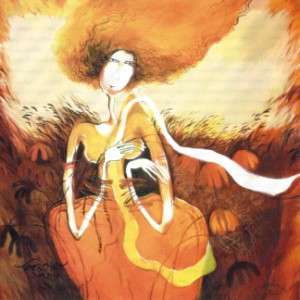Art
In Quest of Harmony
Fayza Haq
 |
Cat, acrylic on canvas, 2009. |
Dead Fish, acrylic on canvas, 2009. |
Couple in a Rickshaw, acrylic on canvas, 2009. Photos: courtesy |
Farida Zaman is one of the most popular professors of the Faculty of Art at Dhaka University. Always helpful, understanding, and a go-getter, she has braved against odds and risen above calamities, to shine in her profession as both teacher and professional painter. She has groomed her children, as best as possible and has taken an active part in numerous workshops and both local and overseas competitions.
 |
Farida Zaman |
Farida has focused on what takes place on our riversides, with our fisherwomen, fish, nets, boats, and the personality of Sufia. “ In my paintings there is always a poem, which I've thought about since childhood. In my early childhood, I used to go the villages with my parents. I often went by boat, with my legs getting wet in the surrounding water, in playful mood. We went to the Hill Tracts of Chittagong, where I went to school, amidst laughter and merriment. In my paintings I've not shown the indigenous people of the Hill Tracts, their beauty, simplicity and innocence.
“ I have, however tried to capture the unfolding and endless beauty of my surrounding nature the hills, with their trees and overhanging creepers and flowers. The river and the trees have inspired me to no end. When I travelled from point to point on bus and train, in Bangladesh, I loved it. Sitting on the train, the benches lined against the isle, I drank deep the beauty of nature. Which I tried to capture on my canvases. The local identity of Bangladesh and its nature with its moonlit trees and fields and its vast skies are what inspired me. When I sit to paint these images of joy and contentment that encourage me to paint. The vastness of the rice fields, the happiness in Sufia's face are what appear before my mind's eye repeatedly.”
When Farida went to study in Barodha and Santiniketan, dong her MS in the first university and PhD in the latter, she went on to look at traditions in various places. In Australia, for instance, she saw the traditional Aboriginal paintings and other artefacts. Before that, having seen the beauty of Bangladesh its pastures, meadows of mustard, trees and birds she realised that one cannot and should not forget one's roots. It's in view of this that Farida brings in the lines, curls and dots in her works. The forms that she brings in are taken from the local community. One finds the sense of enormous space in her paintings. She feels that every artist's work reflects his / her likings in one-way or another. It is not just the essence of beautiful things around her that she wants to depict. In particular it is the beauty of the Bengali women that she wishes to delineate with her brush, paints and canvas. She wants to capture the rhythm and harmony found in Bengali womanhood. There is essence of the simple, women's charm of the rural Bangladesh. Sufia and Amina symbolise the energy and innocence of Bengali women, with their large doe eyes, trailing jet-black hair, and delicate, lissom limbs. The local woman, with her courage, hope and dreams, surrounded by fish, cats, and flowers, are the epitome of joy. The full moon in the skies and the overhanging fishing nets are a part and parcel of the setting for Farida's protagonists. The two characters – Sufia and Amina are personalities taken from every day life. They are children of street women.
 |
Charming, acrylic on canvas, 2009.
Photo: courtesy |
When Farida wishes to depict space in her paintings, she brings in the romantic, billowing fishing nets which contain a woman's dreams. Everything is related, she says, including the cats and fish. She says that when she goes to paint, she can feel the existence of enormous and even smell the wet earth of Bengal, of which poets and playwrights have spoken for many centuries. The paddy fields are elements that Farida has brought in her lines and colours and which she wishes to bring even today though with different lines and colours.
Most artists bring in nostalgic elements in their depiction of joy and contentment of life. “ There are no rough or unpleasant elements in my paintings. If there have been pain and suffering in my life, I don't wish to dwell on them. My paintings are to bring in elements of joie de vivre.” says Farida. For her hope and happiness are important elements of existence. She sees the cup as half full rather than half empty, even in the worst of situations even when her hopes have quite crumbled, and her dreams have remained unfulfilled. In her delineation of life, one finds limitless peace and harmony.
Touching on Santiniketan, where she spent a fair amount of time, she says, "The atmosphere there was 'far from the maddening crowd". There was, naturally, no sound or dust pollution as one finds in most places today except, perhaps in holiday places. Even the seaside is crammed with holidaymakers and photographers, film crews etc. So are hill resorts, with their enveloping clouds and tall trees. The peace and quiet of Santineketan are elements I've enjoyed in my place of study. This is what Rabindranath Tagore wanted for the scholars who came here to study, and learn of 'truth and beauty', the basis of culture. The dry, red soil of Santiniketan is something that fascinated Farida profoundly, one of the reasons why her paintings have the element of tranquillity, says Farida, is because she spent her formative, student days in that home of peace. Conventional university and colleges, in the US and Europe also bear this atmospherewhich inspire hours of concentration and meditation in course of academic studies. The same applies to seats of education in Japan and China. The harshness of one's society in the big cities are not there in these places. One can devote oneself to one's subjects and not get irritate by one's surroundings. The ambiance in such places prompts one to dwell on one's subjects without being irritated or disturbed in one way or another.
|
Copyright
(R) thedailystar.net 2011 |
